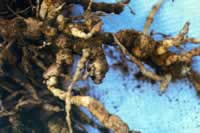Tomato Pests and Diseases
How to Grow Juicy Tasty Tomatoes
Part 5 – Pests and Diseases
 |
| This common root problem which affects plant health and yield can be avoided |
 |
| How can you tell if this plant needs watering or is diseased? |
 |
| What has caused the white scarring on these fruit? |
Q. My plants appear wilted and no amount of watering will revive them
A. Your plants may have a fungal or bacterial disease which causes wilting. There are several types of wilt disease and each has its own specific symptoms. Continuing to water them will not fix the problem.
Q. The leaves and fruits of my plants have spots on them
A. This is a disease which often occurs during wet weather. Do not move about in the crop when it is wet. There is a spray to help prevent this disease.
Q. My plants are stunted
A. There is a number of possible causes for this. A common one affects the roots and it is very important to learn about it and take preventative measures so it doesn’t happen again next year. You can also plant particular companion plants next to your tomatoes to help control this terrible root disease.
Q. My fruit has scars on it and is misshapen
A. This problem occurs mainly in the larger beefsteak varieties and can be avoided by using correct fertilising techniques.
Q. My seedlings appear to have been cut off.
A. Although it seems that someone came along with a pair of scissors and cut the heads off all your seedlings, it is actually caused by a type of worm. There are several things you can do to deter them without using pesticides.
Q. Where can you find detailed answers to these important Pest and Disease questions?
A. In the most comprehensive book ever written about growing tomatoes called “How to Grow Juicy Tasty Tomatoes“. It was written by a professional horticultural technical advisor and provides fully illustrated and detailed information on caring for your tomato plants. It contains comprehensive photos and information on:
- How to control the Damping Off Disease which affects seedlings
- How to recognise wilting diseases and which which varieties are immune
- How to recognise and control the seven spot diseases
- How to take preventative action to avoid viral diseases
- How to recognise and control common pests such as cutworm, aphids, thrips, bollworm, fruitfly, stink bugs and spider mite
- How to identify and control some of the physiological problems such as misshapen fruit, blossom drop, fruit crack, end rot and more
- How to use fungicides and pesticides properly
- Organic controls
But that’s only the beginning – there’s 86 pages of detailed information on
- What to Grow
- How to Grow
- How to nourish and water correctly
- When to pick and how to store
- How to collect seeds
- How to garden organically
 And lots lots more . . . . This “MUST HAVE” compendium answers hundreds of questions that growers from all over the world ask every day. Whether you’re currently getting ready to plant or if your crop is at the fruiting stage – you will find this book extremely useful.
And lots lots more . . . . This “MUST HAVE” compendium answers hundreds of questions that growers from all over the world ask every day. Whether you’re currently getting ready to plant or if your crop is at the fruiting stage – you will find this book extremely useful.











